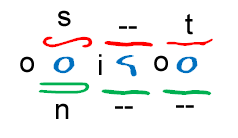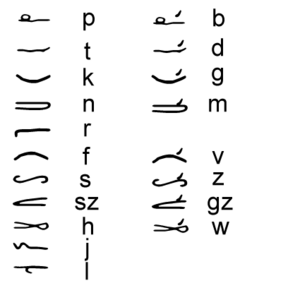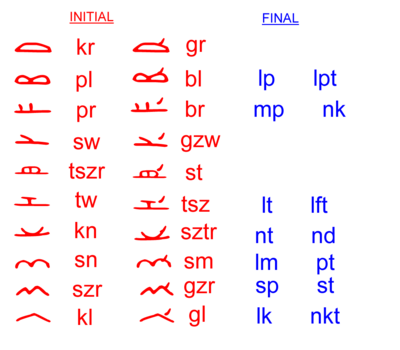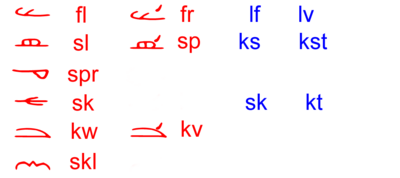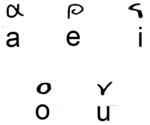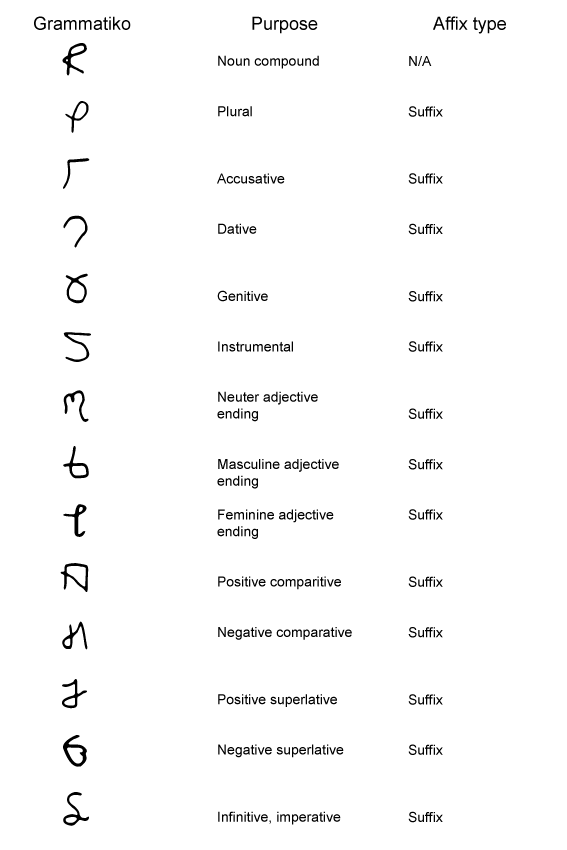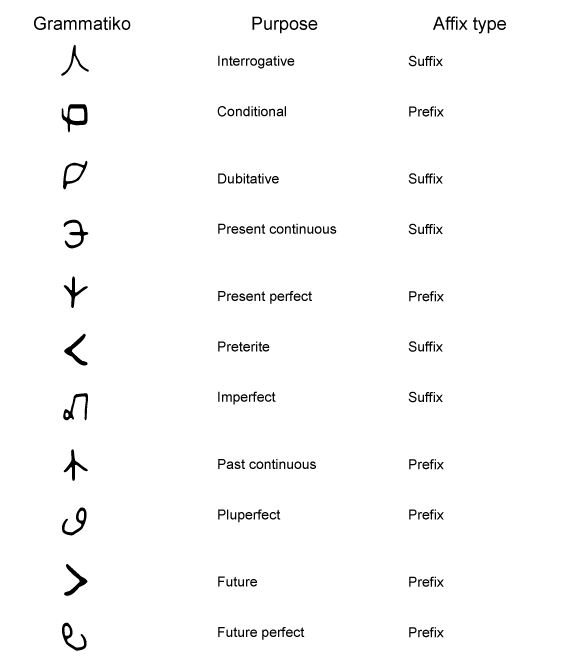Tauro-Piscean writing system
| tacZroZpiSkeSm |
|---|
| Tauro-Piscean | |
|---|---|
| Type: | Alternative - uses ideographic (Grammatikos), alphabetic (Sonitos) and logographic (Tŝinĝi, Affektos) characters |
| Spoken languages: | Tauro-Piscean |
| Creator: | S.C. Anderson |
| Time period: | May 2008 to present |
| Parent systems: | Latin alphabet Hangul |
The modern Tauro-Piscean writing system uses four scripts:
- Sonitos, an alphabet,
- Grammatikos, an ideographic system,
- Tŝinĝi, characters of Chinese origin and
- Affektos, a set of 'standardised emoticons'
Here is an example of text that uses both primary scripts (Sonitos red and Grammatikos green):
Usage of Scripts
Most Tauro-Piscean sentences will contain both Sonitos and Grammatikos. Sonitos are used for stems of articles, nouns, verbs and adjectives, while Grammatikos are used for inflectional endings or variants of said parts of speech.
The writing format is horizontal and read left to right.
Sonitos
Sonitos is a phonemic alphabet organised into syllabic blocks, which are called 'units'. Each unit consists of three letters or 'constituents' that are written vertically top to bottom, the initial and final of which are consonants, zero-consonants or consonant clusters and the medial of which is a vowel.
There are two types of constituent: occupational and supplementary. Occupational constituents represent either one or one of two possible consonants (the latter of which is often the voiced counterpart and marked with a 'dakútên') and these are the same regardless of being in the initial or final position. Here is a table of occupational constituents:
The transliterations match IPA where possible. Sz stands for ʃ, gz stands for dʒ and r stands for ɹ generally, but can be an uvular sound.
Supplementary constituents are harder to learn because each one stands for one or one of two consonant clusters, but represent usually entirely different consonant clusters when in initial and final position.
The medial constituent in a unit is always a vowel (Tauro-Piscean syllables always contain a vowel).
Where there is no consonant in a syllable, the zero-consonant constituent is used. ![]()
Diacritics
Several diacritics are used in conjunction with Sonitos.
Grammatikos
While Sonitos is used to write what is known as the lexical stem of a Tauro-Piscean word, Grammatikos can be affixed to indicate an inflection. Though considered phonetic, Sonitos do not give a true pronunciation guide when combined with Grammatikos; also, Grammatikos only indicate an alteration to meaning such as tense or mood, so the pronunciation of the inflection can vary and rules must be memorised. Here is an example:
![]() This is the neuter definite article 'tet' as a lexical stem. It is spelled with the constituents t, e and t and is thus spelled phonetically.
This is the neuter definite article 'tet' as a lexical stem. It is spelled with the constituents t, e and t and is thus spelled phonetically.
![]() This is the neuter definite article 'ten'. It is spelled with the lexical stem and the Grammatiko that indicates inflection for the accusative case. It is not spelled phonetically.
This is the neuter definite article 'ten'. It is spelled with the lexical stem and the Grammatiko that indicates inflection for the accusative case. It is not spelled phonetically.
![]() This is the neuter definite article 'tem'. It is spelled with the lexical stem and the Grammatiko that indicates inflection for the dative case. It is not spelled phonetically.
This is the neuter definite article 'tem'. It is spelled with the lexical stem and the Grammatiko that indicates inflection for the dative case. It is not spelled phonetically.
There are twenty-five Grammatikos in total, shown below:
For more information on how words are inflected, refer to the article about the Tauro-Piscean language
Note that the noun compound marker is neither prefixed nor suffixed, but lies between the two parts of the noun. Also, while the tense and mood markers are usually affixed to the lexical stem of the verb, in the case of the present perfect, past continuous and future, they are instead affixed to the word that is the subject of the sentence.
Tŝinĝi
Tŝinĝi are the Chinese characters that are used in the Tauro-Piscean writing system. There are ninety-one of them to memorise.
Each character has different readings depending on its relation to characters from other scripts. A Tŝinĝi standing on its own is read as the word whose concept it represents; sometimes, there is more than one possible word from which to choose, but this can be determined via context. Take the following Tŝinĝi, for example:
A Tŝinĝi combined with Sonitos or other Tŝinĝi has two possible readings.
1. Without dakútên, it abbreviates the spelling of a word that consists of more than one syllable. The concept of the character relates, albeit usually indirectly, to the meaning of the word. The usage in this case can be unpredictable and words spelled with Tŝinĝi abbreviations must therefore be learned. For example:
![]() clear, evident (sweotöl - where only töl is written with Sonitos)
clear, evident (sweotöl - where only töl is written with Sonitos)
2. With dakútên, it is read not as a native Tauro-Piscean word, but as a word that is derived from the original Chinese form. The meaning here is more abstract, but tints a word with connotations.
![]() cruel to be kind (hakujïfeêl - literally white-evil; note that the dakútên makes the difference between 'wit' and 'haku')
cruel to be kind (hakujïfeêl - literally white-evil; note that the dakútên makes the difference between 'wit' and 'haku')
